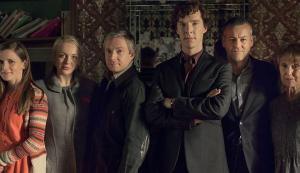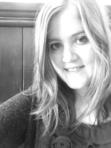7 Canonical References in The Empty Hearse
Ahoy, Matey, here there be spoilers! Read on at your own risk.
Not only was Sherlock Series 3′s first episode a knockout example of television; it also contained the numerous references to the original Doyle stories that fans have come to expect. I’m listing seven, in no particular order, though there were many more, some I’m sure I haven’t even thought about.
1) Reunion in disguise
In “The Adventure of the Empty House,” which features the return of Sherlock Holmes after the Great Hiatus, Holmes first greets Watson disguised as an elderly bookseller, and only after Watson fails to recognize him does he reveal his true character.
BBC Sherlock has been light on actual disguise up to now, but Mark Gatiss chose to pay homage to the canon when he had Sherlock disguise himself as a waiter to surprise his friend after his two-year absence and supposed death. The sheer lack of emotional acuity this required will no doubt be discussed for years to come.
2) Big Bad Moran
The plot of “The Empty Hearse” bears little resemblance to “The Empty House,” but Gatiss did choose to stick with Moran as the villain of Sherlock’s return story. In canon, Moran is Moriarty’s second-in-command and the key to taking down his organization. Sherlock did not borrow that plot point from Doyle, but did retain the idea of Moran as a powerful, shady figure with sinister plans.
Gatiss (and co.) also connected Moran to the giant rat of Sumatra, a brief canon reference and perennial fan favorite.
3) John or James
In “The Empty Hearse,” a mysterious enemy sends Mary a text that contains a code. Many of the words are irrelevant, but sharp-eyed fans will have noted the phrase “John or James,” which is most likely a nod to the fact that in the canon, Mary Morstan once famously called her then-husband John Watson “James,” a continuity issue that has puzzled fans for generations.
4) Deduce-Off
In one of the most amusing sequences of “The Empty Hearse,” Sherlock and Mycroft engage in a competition of deductive skill. This directly mirrors their interaction in Doyle’s story “The Greek Interpreter” in which they similarly put their skills to use and Mycroft proves even cleverer than his younger brother.
5) Mrs. Hudson’s Hysterics
Una Stubbs added warmth and comic relief throughout “The Empty Hearse,” but her frying pan-wielding hysterics were straight from the canon. In “The Empty House,” Holmes casually tells Watson that he, “threw Mrs. Hudson into violent hysterics,” by returning from the dead, and Sherlock certainly took the idea literally.
6) Sherlock’s Nonchalance
One of the biggest conversations fans across the globe are having post- “Empty Hearse” is about Sherlock’s perceived lack of emotional sensitivity upon his return, most notably to Watson, but to his other friends as well. This tracks completely with Doyle’s description of Holmes’s return in “The Empty House,” during which Holmes says to Watson that he “had no idea that you would be so affected” and generally acts like perceived death and extended absence are no big deal. Love it or hate it, Gatiss’s characterization of Holmes in the episode mirrors Doyle’s, both in its tenderness and, at times, baffling lack of human understanding.
7) Mary’s Tolerance
The fan community had a certain amount of trepidation about Mary’s characterization in “The Empty Hearse,” but she proved to be sweet, strong, complex, and ultimately invested in the deep friendship of her fiance and Sherlock Holmes. Her character in general dovetailed with the descriptions of her throughout Doyle’s Sign of Four, but more specifically, her willingness to intercede with John on Sherlock’s behalf speaks to the fact that for a great deal of the Doyle canon, she allows her husband apparently unrestricted and unhenpecked freedom to pursue his crimefighting activities with the detective. This, along with her positive interactions with Holmes in The Sign of Four, suggests that she has a high opinion of Holmes much like the one “Empty Hearse” has begun to establish.
_____________________________________________
The Detective, The Woman and The Winking Tree: A Novel of Sherlock Holmes is available from all good bookstores and e-bookstores worldwide including in the USA Amazon,Barnes and Noble and Classic Specialities - and in all electronic formats including Amazon Kindle , iTunes(iPad/iPhone) and Kobo.
The Detective and the Woman: A Novel of Sherlock Holmes is available from all good bookstores and e-bookstores worldwide including in the USA Amazon,Barnes and Noble and Classic Specialities - and in all electronic formats including Amazon Kindle , iTunes(iPad/iPhone) and Kobo.






